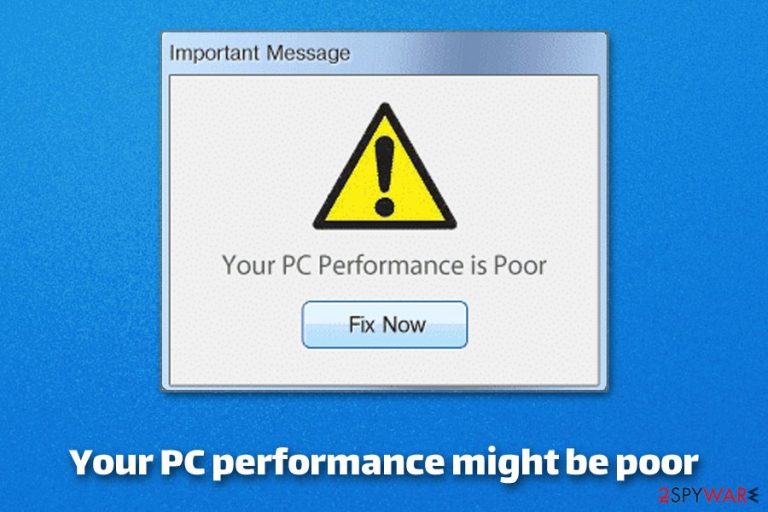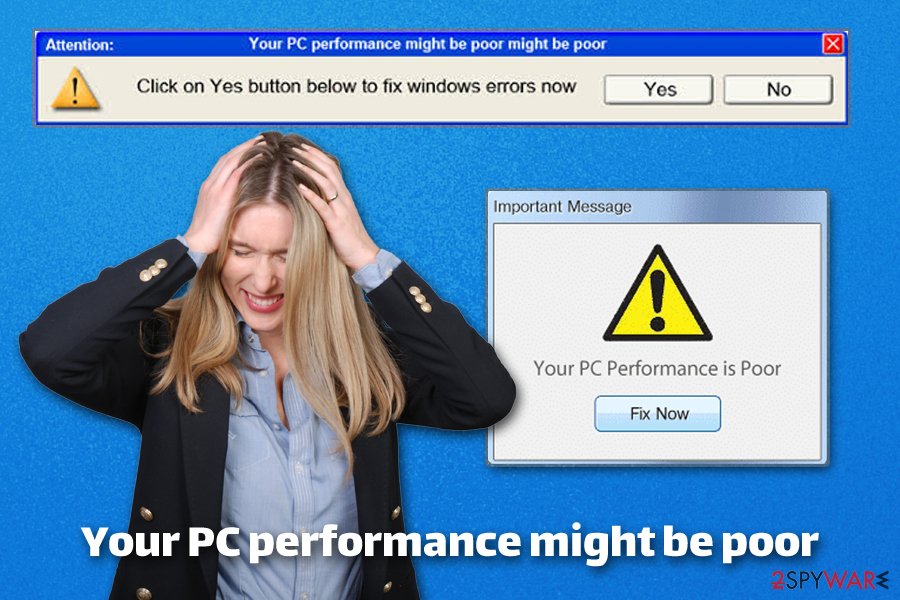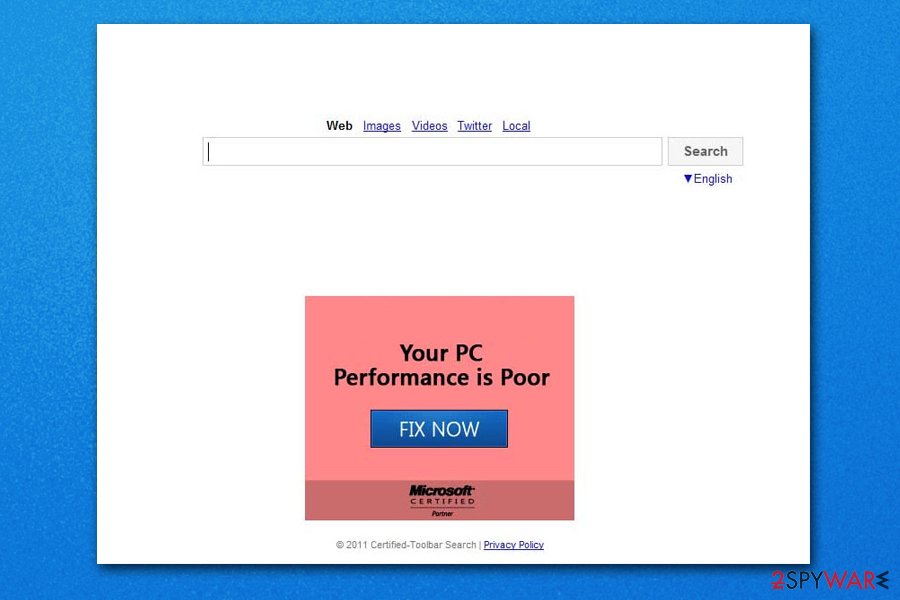‘Your PC performance might be poor’ virus (Virus Removal Guide) - Dec 2019 update
‘Your PC performance might be poor’ virus Removal Guide
What is ‘Your PC performance might be poor’ virus?
Your PC performance might be poor is a scam that might trick users to install malware on their computers

“Your PC performance might be poor” is a misleading notification that may show up on your computer during web browsing sessions on Google Chrome, Mozilla Firefox, Safari, Internet Explorer, or any other web browsers at any time. Just like many other online scams, this fake alert tries to catch users off-guard, trying to imitate a legitimate message that users might have seen previously. “Your PC performance might be poor” scam claims the following:
Your PC performance might be poor
Click on Yes button below to fix windows errors now
Because the “Your PC performance might be poor” pop-up is presented in a pop-up that looks like it is coming from a browser, many inexperienced users might follow the provided instructions and install potentially unwanted programs[1] or malware on their computers. Thus, never believe “Your PC performance might be poor” message, as you may harm your online safety and infect your computer with malicious software.
| Name | “Your PC performance might be poor” |
| Type | Online scam, fake alert |
| Causes | The fake pop-up might show up once a malicious website is visited or be triggered by secretly installed adware/malware, as well as background scripts |
| Symptoms | The pop-up message shows up seemingly out of nowhere and claims that computer performance is poor. If the PC is infected with adware, users may also see redirects to suspicious sites, sponsored links in search results, web browser changes (i.e., homepage and search engine), intrusive ads, and experience other symptoms |
| Main dangers | Installation of other potentially unwanted programs or malware, sensitive information disclosure to unknown parties |
| Removal | Scan the device with anti-malware software or check the instructions below |
| Recovery & optimization | If the machine was infected with adware or malware, we recommend scanning it with FortectIntego for virus damage fix |
There are several reasons why you might be seeing “Your PC performance might be poor” alert. First of all, the message might be triggered by you stumbling upon a malicious website accidentally, although a malicious JavaScript can also be the cause of it. Additionally, the redirects to sites that show “Your PC performance might be poor” scam can also be a sign of adware infection.
You should never click “Yes” and especially not download/install anything suggested by the malicious “Your PC performance might be poor” pop-up. In case you do, you might end up with malware like ransomware[2] or a Trojan on your machine, which might render your personal files useless or send sensitive information (such as credit card details) directly to cybercriminals without your knowledge. The worst part is that the latter might hide inside the system for a prolonged period of time, and you will not know that malicious activity is taking place.
“Your PC performance might be poor” is created by cybercriminals who are willing to monetize by tricking and harming innocent users. To make the scam more believable, crooks often employ social engineering skills – an art of manipulating users into believing something that is not true/real.
Unfortunately, because there are many computer users who are not that familiar with how malware or computers work, scams like “Your PC performance might be poor” are successful more often than not. Fortunately, many users are by now aware of the online dangers, and cybersecurity advisers[3] and security sites often warn about the most popular scams and phishing attempts.

To remove “Your PC performance might be poor” virus, you should not click “No” or the “X” button, but simply leave the page which triggered the fake alert. In case it is impossible to close it, you should call up the Task Manager (or Activity Monitor on macOS) and shut down the process of your browser.
However, “Your PC performance might be poor” removal might not end just there. In case your computer is infected with adware, you will also have to eliminate it to stop the unwanted activity on your machine, which may include the following symptoms:
- Web browser redirects to scam, phishing, and other suspicious sites;
- Intrusive ads are shown on all visited websites;
- Search results filled with sponsored links that lead to predetermined sites;
- Changed homepage, new tab URL, and the search engine;
- Slow browser response time, etc.
Note that malware might be present on your system too. Thus, if you noticed any suspicious activity even after leaving the malicious site that shows “Your PC performance might be poor” pop-up, you should scan your machine with anti-malware software. Another way to check for potentially unwanted programs is by checking the list of the installed apps as per our instructions below.
If you indeed find PUPs or malware on your system, get rid of it with anti-malware software. Also, for the best results, we also recommend using the PC repair tool FortectIntego and reset all the installed browsers.
Avoid the installation of potentially unwanted programs
The constantly occurring data breaches and new malware strains like Djvu ransomware became the epidemic of modern times. Despite the rising awareness of all the internet users, there are many that are unwilling to listen and protect themselves as required in order to prevent computer infections; in other cases, users simply lack basic computer skills to avoid unwanted programs and malware infiltration.
Installing comprehensive security software is not enough, however, and users need to always combine it with good online browsing practices. As previously mentioned, cybercriminals often employ social engineering to make users perform actions they otherwise would not, i.e., installing unwanted software on their machines.
To protect yourself from phishing attacks, never believe pop-ups and warning messages coming from various websites and claiming virus infections, data theft, and threatening with consequences. Only install software from trusted sources (avoid torrents) and always pick Advanced/Custom settings during the installation process of freeware/shareware to get rid of all the optional components before they manage to enter your PC.

“Your PC performance might be poor” removal may be as simple as closing down the malicious site in some cases
As mentioned above, “Your PC performance might be poor” removal might consist of simply closing down the tab of the malicious web page that you came across. It is absolutely vital not to download anything offered by the fake alert or to click the “Yes” button, as it may trigger the installation of malware in the background. In the best-case scenario, you might end up with bloatware[4] programs like Full System Care, Pro PC Cleaner, and others – these can also harm the computer by performing inadequate changes to it.
All in all, to remove “Your PC performance might be poor” virus along with anything that might be installed on your device, scan it with security software. If the infection is triggered by adware, you might be lucky and eliminate it manually by using our instructions below. Additionally, you should reset all the installed browsers.
You may remove virus damage with a help of FortectIntego. SpyHunter 5Combo Cleaner and Malwarebytes are recommended to detect potentially unwanted programs and viruses with all their files and registry entries that are related to them.
Getting rid of ‘Your PC performance might be poor’ virus. Follow these steps
Uninstall from Windows
Get rid of potentially unwanted programs from Windows systems:
Instructions for Windows 10/8 machines:
- Enter Control Panel into Windows search box and hit Enter or click on the search result.
- Under Programs, select Uninstall a program.

- From the list, find the entry of the suspicious program.
- Right-click on the application and select Uninstall.
- If User Account Control shows up, click Yes.
- Wait till uninstallation process is complete and click OK.

If you are Windows 7/XP user, proceed with the following instructions:
- Click on Windows Start > Control Panel located on the right pane (if you are Windows XP user, click on Add/Remove Programs).
- In Control Panel, select Programs > Uninstall a program.

- Pick the unwanted application by clicking on it once.
- At the top, click Uninstall/Change.
- In the confirmation prompt, pick Yes.
- Click OK once the removal process is finished.
Delete from macOS
Remove items from Applications folder:
- From the menu bar, select Go > Applications.
- In the Applications folder, look for all related entries.
- Click on the app and drag it to Trash (or right-click and pick Move to Trash)

To fully remove an unwanted app, you need to access Application Support, LaunchAgents, and LaunchDaemons folders and delete relevant files:
- Select Go > Go to Folder.
- Enter /Library/Application Support and click Go or press Enter.
- In the Application Support folder, look for any dubious entries and then delete them.
- Now enter /Library/LaunchAgents and /Library/LaunchDaemons folders the same way and terminate all the related .plist files.

Remove from Microsoft Edge
Delete unwanted extensions from MS Edge:
- Select Menu (three horizontal dots at the top-right of the browser window) and pick Extensions.
- From the list, pick the extension and click on the Gear icon.
- Click on Uninstall at the bottom.

Clear cookies and other browser data:
- Click on the Menu (three horizontal dots at the top-right of the browser window) and select Privacy & security.
- Under Clear browsing data, pick Choose what to clear.
- Select everything (apart from passwords, although you might want to include Media licenses as well, if applicable) and click on Clear.

Restore new tab and homepage settings:
- Click the menu icon and choose Settings.
- Then find On startup section.
- Click Disable if you found any suspicious domain.
Reset MS Edge if the above steps did not work:
- Press on Ctrl + Shift + Esc to open Task Manager.
- Click on More details arrow at the bottom of the window.
- Select Details tab.
- Now scroll down and locate every entry with Microsoft Edge name in it. Right-click on each of them and select End Task to stop MS Edge from running.

If this solution failed to help you, you need to use an advanced Edge reset method. Note that you need to backup your data before proceeding.
- Find the following folder on your computer: C:\\Users\\%username%\\AppData\\Local\\Packages\\Microsoft.MicrosoftEdge_8wekyb3d8bbwe.
- Press Ctrl + A on your keyboard to select all folders.
- Right-click on them and pick Delete

- Now right-click on the Start button and pick Windows PowerShell (Admin).
- When the new window opens, copy and paste the following command, and then press Enter:
Get-AppXPackage -AllUsers -Name Microsoft.MicrosoftEdge | Foreach {Add-AppxPackage -DisableDevelopmentMode -Register “$($_.InstallLocation)\\AppXManifest.xml” -Verbose

Instructions for Chromium-based Edge
Delete extensions from MS Edge (Chromium):
- Open Edge and click select Settings > Extensions.
- Delete unwanted extensions by clicking Remove.

Clear cache and site data:
- Click on Menu and go to Settings.
- Select Privacy, search and services.
- Under Clear browsing data, pick Choose what to clear.
- Under Time range, pick All time.
- Select Clear now.

Reset Chromium-based MS Edge:
- Click on Menu and select Settings.
- On the left side, pick Reset settings.
- Select Restore settings to their default values.
- Confirm with Reset.

Remove from Mozilla Firefox (FF)
Remove dangerous extensions:
- Open Mozilla Firefox browser and click on the Menu (three horizontal lines at the top-right of the window).
- Select Add-ons.
- In here, select unwanted plugin and click Remove.

Reset the homepage:
- Click three horizontal lines at the top right corner to open the menu.
- Choose Options.
- Under Home options, enter your preferred site that will open every time you newly open the Mozilla Firefox.
Clear cookies and site data:
- Click Menu and pick Settings.
- Go to Privacy & Security section.
- Scroll down to locate Cookies and Site Data.
- Click on Clear Data…
- Select Cookies and Site Data, as well as Cached Web Content and press Clear.

Reset Mozilla Firefox
If clearing the browser as explained above did not help, reset Mozilla Firefox:
- Open Mozilla Firefox browser and click the Menu.
- Go to Help and then choose Troubleshooting Information.

- Under Give Firefox a tune up section, click on Refresh Firefox…
- Once the pop-up shows up, confirm the action by pressing on Refresh Firefox.

Remove from Google Chrome
Reset Google Chrome once you remove all the PUPs from your machine:
Delete malicious extensions from Google Chrome:
- Open Google Chrome, click on the Menu (three vertical dots at the top-right corner) and select More tools > Extensions.
- In the newly opened window, you will see all the installed extensions. Uninstall all the suspicious plugins that might be related to the unwanted program by clicking Remove.

Clear cache and web data from Chrome:
- Click on Menu and pick Settings.
- Under Privacy and security, select Clear browsing data.
- Select Browsing history, Cookies and other site data, as well as Cached images and files.
- Click Clear data.

Change your homepage:
- Click menu and choose Settings.
- Look for a suspicious site in the On startup section.
- Click on Open a specific or set of pages and click on three dots to find the Remove option.
Reset Google Chrome:
If the previous methods did not help you, reset Google Chrome to eliminate all the unwanted components:
- Click on Menu and select Settings.
- In the Settings, scroll down and click Advanced.
- Scroll down and locate Reset and clean up section.
- Now click Restore settings to their original defaults.
- Confirm with Reset settings.

Delete from Safari
Remove unwanted extensions from Safari:
- Click Safari > Preferences…
- In the new window, pick Extensions.
- Select the unwanted extension and select Uninstall.

Clear cookies and other website data from Safari:
- Click Safari > Clear History…
- From the drop-down menu under Clear, pick all history.
- Confirm with Clear History.

Reset Safari if the above-mentioned steps did not help you:
- Click Safari > Preferences…
- Go to Advanced tab.
- Tick the Show Develop menu in menu bar.
- From the menu bar, click Develop, and then select Empty Caches.

After uninstalling this potentially unwanted program (PUP) and fixing each of your web browsers, we recommend you to scan your PC system with a reputable anti-spyware. This will help you to get rid of ‘Your PC performance might be poor’ registry traces and will also identify related parasites or possible malware infections on your computer. For that you can use our top-rated malware remover: FortectIntego, SpyHunter 5Combo Cleaner or Malwarebytes.
How to prevent from getting adware
Stream videos without limitations, no matter where you are
There are multiple parties that could find out almost anything about you by checking your online activity. While this is highly unlikely, advertisers and tech companies are constantly tracking you online. The first step to privacy should be a secure browser that focuses on tracker reduction to a minimum.
Even if you employ a secure browser, you will not be able to access websites that are restricted due to local government laws or other reasons. In other words, you may not be able to stream Disney+ or US-based Netflix in some countries. To bypass these restrictions, you can employ a powerful Private Internet Access VPN, which provides dedicated servers for torrenting and streaming, not slowing you down in the process.
Data backups are important – recover your lost files
Ransomware is one of the biggest threats to personal data. Once it is executed on a machine, it launches a sophisticated encryption algorithm that locks all your files, although it does not destroy them. The most common misconception is that anti-malware software can return files to their previous states. This is not true, however, and data remains locked after the malicious payload is deleted.
While regular data backups are the only secure method to recover your files after a ransomware attack, tools such as Data Recovery Pro can also be effective and restore at least some of your lost data.
- ^ Chris Hoffman. PUPs Explained: What is a “Potentially Unwanted Program”?. How-To Geek. Site that explains technology.
- ^ What is Ransomware?. Forcepoint. Security blog.
- ^ Dieviren. Dieviren. Cybersecurity insights.
- ^ Bloatware. Techopedia. Where IT and Business Meet.
